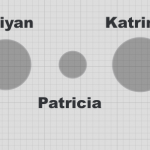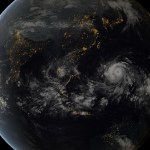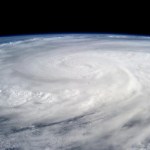Haiyan
CNN is calling Hurricane Patricia "The Most Dangerous Hurricane in History." Another news outlet showed a picture of the hurricane and pointed out "The Enormous Size of Hurricane Patricia."
Both of these are wrong. Size matters with hurricanes. A category 5 hurricane that is twice as large as another category 5 hurricane is "more dangerous" all else being equal, and by "all else" I mean things like exactly where it hits, how fast it is moving, exactly how strong it is (category 5 includes a very wide range of wind speeds because it is the highest category). Hurricane Patricia is not huge.…
Typhoon Haiyan, which made landfall in the Philippines on Nov. 7, is another sobering reminder of the severe weather we are provoking through climate change. It is unofficially the strongest recorded cyclone to ever make landfall, with wind speeds up to 195 mph, 70% stronger than Hurricane Sandy. Villages are flattened, and more than 5,000 people are confirmed dead (as of 11/22). Greg Laden says that tropical cyclones feed on heat energy from the sea’s surface, from seas we know are getting warmer. Haiyan was a storm that blew past the most dire classification, Category 5, which tops out at a…
Update on Haiyan/Yolanda Death Toll
The final figures are not likely in but the numbers have stabilized and we can now probably put a number to the human toll of this storm that will not change dramatically in the future, at least in terms of orders of magnitude. The current “official” death toll in the Philippines from Typhoon Yolanda/Haiyan is 6,009 with 1,779 missing and 27,022 injured, with the largest concentration of casualties in Eastern Visayas. This comes from a December 13th report of the National Disaster Risk Reduction and Management Council, which you can (probably) download here…
While reading an AP attributed article on Huffington post about Super Typhoon Haiyan (also known as Yolanda), I did a double take at this paragraph:
Weather officials said Haiyan had sustained winds of 235 kilometers per hour (147 miles per hour), with gusts of 275 kph (170 mph), when it made landfall. By those measurements, Haiyan would be comparable to a strong Category 4 hurricane in the U.S., and nearly in the top category, a 5. Hurricanes, cyclones and typhoons are the same thing. They are just called different names in different parts of the world.
It struck me because "nearly in the…
Should there be a Category 6, or even a Category 7, to classify extra bit tropical cyclones like Haiyan?
Some tropical cyclones labeled Category 5 are much stronger than others. It has been suggested that we would be smart to extend the system to have a Category 6 and maybe even a Category 7 to allow the additional severity of these storms to be indicated when they are being spoken of in the news or by officials in charge of scaring people into doing the right thing, like running away or staying indoors.
There is resistance to this proposal that comes from two mostly distinct places. One is…
At this moment, there is a guest post over at WUWT blog downplaying the size, strength, wind speeds, overall effects, and even the death toll of Super Typhoon Haiyan. Even as the monster storm steams across the sea to it's next landfall (probably as a huge wet tropical storm, in northern Vietnam and southern China), Anthony Watts and his crew are trying to pretend this monster storm didn't happen, and instead, that it was a run of the mill typhoon.
At the moment, nobody is really saying that Haiyan's strength, size, power, or even existence is specifically the direct result of global warming…





